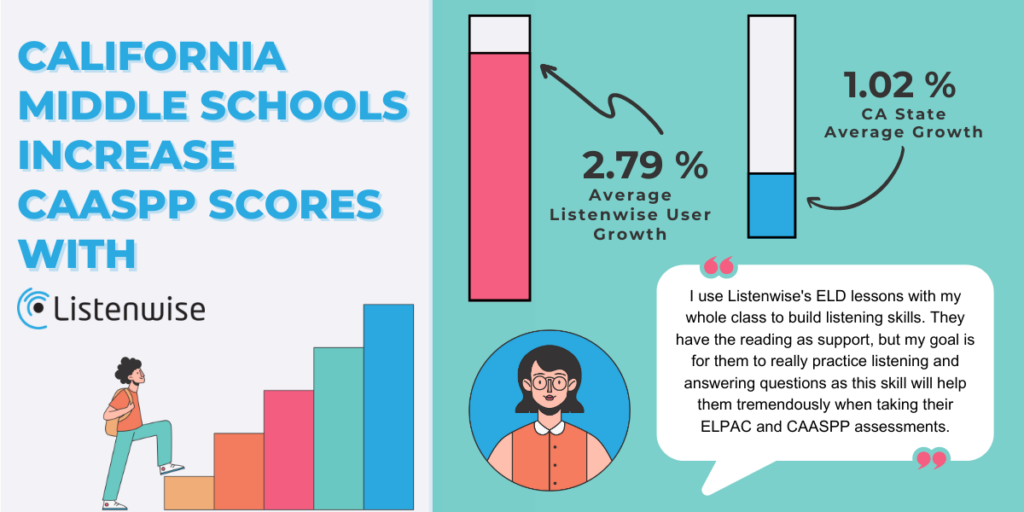Last Updated on December 17, 2024
 Are you seeking to improve your listening scores on the SBAC, CAASPP, ELPAC, ILEARN, English I and II assessments, TELPAS, WIDA, or other standardized tests?
Are you seeking to improve your listening scores on the SBAC, CAASPP, ELPAC, ILEARN, English I and II assessments, TELPAS, WIDA, or other standardized tests?
ELA and ESL state assessments focus on listening skills in at least 22 states and counting. We know that test preparation can be stressful for teachers and students alike, and we are ready to help.
At Listenwise, we have sought to create tools that support listening instruction for state assessment prep, while keeping instruction authentically focused on relevant, engaging content with learning benefits that extend well beyond test prep. Teaching students how to listen is important for literacy, critical thinking, social-emotional learning, and success in college and the workplace. Listenwise is designed to support all of these goals.
Listenwise as a State Assessment Prep Tool
Listenwise can help teachers assess students’ listening comprehension with auto-scored quizzes. It can help students practice note-taking while actively listening, thinking critically about academic content, and responding to short-response questions. All of these features can help students prepare for the listening sections of standardized assessments.
Most of the state assessments provide audio content without closed captions or transcripts, so when teachers want to emulate these situations to provide testing practice on the Listenwise platform, they can hide the interactive transcripts. In other instructional situations, using interactive transcripts can provide helpful support that increases listening comprehension.
I’ve been using Listenwise for two years as a weekly assignment for my ELA and ELD 7th and 8th grade students. Listenwise lessons help with listening and speaking standards as well as comprehension and story plot. It hit everything for CAASPP and ELPAC!
– Middle School Teacher in California
For example, in the state test for ELA in California (CAASPP), listening passages include short informational texts that are read aloud by one speaker. The passages are typically related to common grade-level curriculum topics. In order to practice for the CAASPP, teachers can start using Listenwise with the transcripts, and when they get closer to testing time, remove the transcripts so that students can practice listening without reading along. Students can also practice taking notes while listening to the Listenwise podcasts, and they can replay the podcast multiple times. See this test example using an excerpt from “The Birth of a Democracy.”
For teachers with students taking the English Learner Proficiency Assessments for California (ELPAC), practice sessions should also include audio stories played once from the front of the classroom, as students need to learn how to listen to a passage only once without using interactive transcripts to read along. Instructions should focus on precise and strategic listening to help students practice key listening comprehension skills for the test.
Listen to two teachers from Vista Unified School District share how they have built a weekly routine around Listenwise in order to prepare their students for the ELPAC:
Texas teachers use Listenwise lessons to address TEKS and ELPS standards for TELPAS. Watch Royal ISD Principal Melissa Rincón talk about how her school’s TELPAS scores led to their adoption of Listenwise:
Teachers in WIDA states love that Listenwise is easily customizable in order to replicate the WIDA ACCESS exam. We have an in-depth blog post that walks you through the customization process in order to add Listenwise to your state assessment prep plan. Learn more about using Listenwise as ACCESS test prep.
Why Focus on Listening?
With listening still ranking among the lowest literacy scores in California, listening is an important skill to integrate into classroom instruction across the curriculum.
In California 79% of our middle school users increased their listening scores from 2017 to 2019, and Listenwise users outperformed average growth across the state of California.
“We have found Listenwise to be an excellent tool to prepare EL students for the Listening section of the English Language Proficiency Assessment of California (ELPAC). The test requires students to listen to long passages only once and then recall information. Listenwise gives teachers the opportunity to have students practice in a group setting and individually at home. Additionally, at the high school level, students do not take the CAASPP in 9th or 10th grade, so using Listenwise at those grade levels gives students a chance to continue to interact with and attempt materials and questions similar to the test, so that they do not lose the prerequisite skill sets they need when they take the test again as juniors. Active listening is an incredibly important life skill, and Listenwise lets students practice in a way that is engaging and fun.”
-High School Teacher Specialist in California
As other states begin to test listening, educators will continue to see the importance of teaching listening as an integral part of their literacy instruction. If you are not a California educator, your state ELA tests that address speaking and listening standards will likely function similarly to the CAASPP.

Using Listenwise more than once a week with your students and assigning Listenwise listening comprehension quizzes will help your students practice active listening, recognize literal meaning, make inferences, and identify the main idea. Use the Listenwise graphic organizers to help your students take notes and focus while listening, and monitor students’ growth by tracking and analyzing their quiz data.
State Assessment Prep Materials & Resources
To help with state assessment prep, we have collected some informative blog posts and teacher testimonials about integrating listening instruction into teaching:
- How Listenwise Improved My Students CAASPP Listening Scores (recorded webinar)
- Charmetra Charmon Uses Listenwise to Prepare Students for the SBAC (practice for annotating as well as listening)
- Comparing CAASPP and ELPAC Listening Assessments (blog post)
- Scott Petri – Scaffolding Listenwise Activities to Prepare for the CAASPP (YouTube clip)
- Katie Booth – Addressing Curriculum Topics and Speaking & Listening Standards (YouTube clip)
- Increasing Performance on Listening Assessments (blog post)
- Listenwise Comprehension Assessments Align with CCSS Speaking & Listening Standards.(blog post)
- Lesson Ideas from Listenwise Advocates (blog post)
Other Resources for State Assessment Prep:
- Planned Speaking Practice (blog post) – Interaction, oral language, speaking practice, cooperative learning, discussion groups…There are many ways to incorporate speaking practice into instruction. The first step is planning for purposeful talk and providing many opportunities for interaction.
- Oracy Classroom Effective Strategies (Edutopia blog post) Explore strategies for developing confident speakers who can share their thoughts and learning.
- The Big List of Class Discussion Strategies (Cult of Pedagogy blog post and podcast) 15 formats for structuring a class discussion to make it more engaging, more organized, more equitable, and more academically challenging.
- What You Learn from Listening to Great Speeches (blog post) Speaking and listening must go beyond “turn and talk” opportunities. Students must be able to present information to small groups and large audiences.
- How to Podcast in Class: Part 1 (blog post) Podcasting hits speaking and listening goals and is a cross-curricular activity. Best of all, you don’t need a lot of equipment to get started.
- How to Use Listenwise to Improve Listening, Literacy, and Language Skills (blog post) Listenwise is uniquely designed to meet speaking and listening standards while teaching important content. Listenwise podcasts can be used together with texts and other media to spark conversations and analytical thinking.
- 5 Reasons You Should Teach Listening (blog post) There are many purposes for listening, including understanding and thoughtfully responding to a speaker’s intended message. Teachers can teach students how to listen for a variety of purposes using instructional resources on the Listenwise platform.
- Teaching Written Argument with Debate Stories (blog post) Listenwise debate stories offer discussion and analysis of a variety of interesting contemporary issues that are well suited for practicing written argument.
- Appsmashing Listenwise & Newsela (blog post) Pairing text sets and podcasts can help students develop listening, reading, writing, speaking, and critical thinking skills.
- Appsmashing Listenwise & Flipgrid for Student Inquiry (blog post) Appsmashing listening and speaking tools can help students formulate and investigate their own questions.
- Facilitating Online Discussions Using Google Classroom (blog post) Well-framed, authentic, respectful academic online discussions can provide opportunities for students to build effective arguments backed with evidence, make connections between someone else’s experiences and their own, or explain their understanding of a complex phenomenon using academic language.
